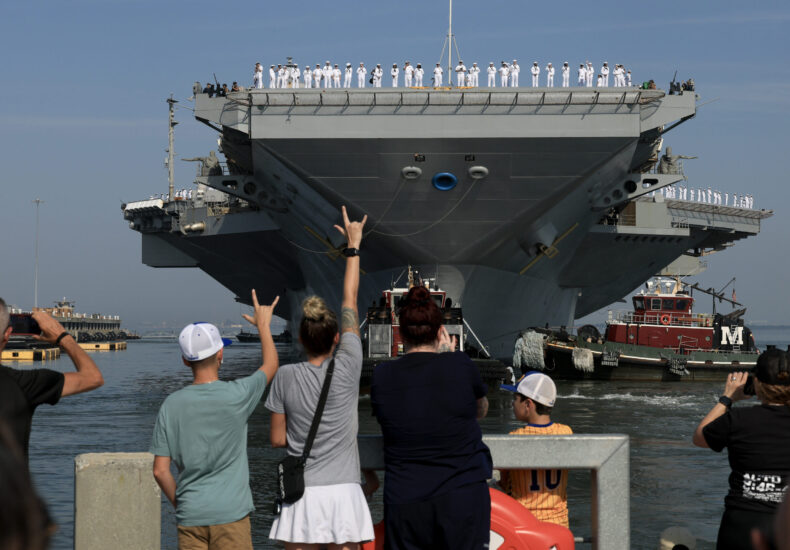
US Deploys Advanced Carrier to Caribbean as Venezuela Tensions Escalate
The Pentagon is escalating the Trump administration’s military campaign against drug trafficking by deploying the Navy’s most advanced aircraft carrier to the Caribbean. Defense Secretary Pete Hegseth has directed the USS Gerald R. Ford carrier strike group, currently stationed in the Mediterranean, to redeploy to the region, Pentagon spokesman Sean Parnell announced on Friday.
This move brings dozens of additional fighter and surveillance aircraft, accompanied by Navy warships, marking the most significant military signal yet that President Trump is prepared to launch strikes on land targets. According to two Navy officials, this initiative aims to dismantle drug smuggling operations in the region.
The last comparable carrier deployment occurred in late 2024, when the USS Gerald R. Ford was sent to the Red Sea for airstrikes against Houthi rebels in Yemen.
At a White House event on Thursday, President Trump made a stark declaration: “I don’t think we’re going to necessarily ask for a declaration of war, I think we’re just going to kill people that are bringing drugs into our country. OK? We’re going to kill them. You know? They’re going to be, like, dead.”
Last week, Trump announced authorization for the CIA to conduct covert actions in Venezuela and revealed that the U.S. was considering expanding its military campaign to include land operations. “We are certainly looking at land now, because we’ve got the sea very well under control,” he told reporters.
To date, U.S. operations have primarily targeted vessels in the Caribbean and the eastern Pacific Ocean. The administration reports that at least 10 boats have been attacked, resulting in 43 fatalities.
U.S. Defense Secretary Pete Hegseth reinforced the administration’s hardline stance on X (formerly Twitter), stating, “If you are a narco-terrorist smuggling drugs in our hemisphere, we will treat you like we treat Al-Qaeda. Day or NIGHT, we will map your networks, track your people, hunt you down, and kill you,” alongside footage of a recent Caribbean boat strike.
This carrier deployment also signals a strategic pivot, shifting focus away from Europe and the Middle East. For the first time in decades, no U.S. aircraft carrier will be stationed in either the U.S. Central Command, covering the Middle East, or the U.S. European Command. This repositioning may impact ongoing negotiations related to conflicts in Gaza and Ukraine.
### About the USS Gerald R. Ford
Commissioned in 2017, the USS Gerald R. Ford is the largest warship ever deployed by the United States, displacing over 100,000 tons and stretching 1,100 feet in length. The carrier hosts nearly 4,600 personnel, including its air wing.
Its primary offensive capabilities come from F/A-18 fighter jets, which can carry air-to-air, air-to-ground, and anti-ship missiles, as well as laser-guided bombs. These jets have a maximum combat range of 1,250 miles. In addition, the Ford carries electronic-jamming aircraft, airborne early warning planes, cargo aircraft, and helicopters.
### Intensified Military Buildup in the Caribbean
The USS Gerald R. Ford joins the largest military buildup in the Caribbean in decades. On Thursday, B-1 bombers flew near Venezuela shortly after B-52 bombers conducted an “attack demonstration” in the vicinity. Defense officials indicate that bomber missions are expected to increase.
Currently, the region hosts eight warships, F-35B fighters, P-8 Poseidon surveillance planes, AC-130J Ghostrider gunships, MQ-9 Reaper drones, and other advanced military assets. The USS Gravely destroyer, along with Marine units, is scheduled to visit Trinidad and Tobago—just six miles from Venezuela—under an existing Status of Forces Agreement.
### Pressure on Venezuelan Leadership
The deployment is clearly intended to intensify pressure on Venezuelan President Nicolás Maduro, whom the Trump administration labels an illegitimate leader overseeing a criminal cartel—a charge Maduro rejects. The U.S. offers a $50 million reward for information leading to his arrest.
In response, Venezuela has positioned 5,000 Russian-made Igla-S anti-aircraft missiles at “key air defense positions,” President Maduro stated during a military event broadcast by Venezolana de Televisión on Wednesday.
“Any military force in the world knows the power of the Igla-S, and Venezuela has no less than 5,000 of them,” he asserted. These portable missiles, similar in capability to American Stingers, are short-range, low-altitude systems capable of targeting cruise missiles, drones, helicopters, and low-flying aircraft.
Maduro emphasized that these missiles have been deployed throughout the country, “even in the last mountain, the last town, and the last city of the territory.”
He has also been repositioning troops and mobilizing militia members in response to increased U.S. military activity. Speaking last week, Maduro said, “The people of Venezuela are clear, united, and aware. They have the means to once again defeat this open conspiracy against the peace and stability of Venezuela.”
—
This deployment underscores the Trump administration’s commitment to an intensified, multifaceted approach targeting drug trafficking networks and dissenting regimes in the Americas, signaling a new chapter in U.S. military engagement in the region.
https://www.nysun.com/article/us-deploys-advanced-carrier-to-caribbean-as-venezuela-tensions-escalate
You may also like
You may be interested
Congress Leader Rahul Gandhi Says He’s ‘Getting Help From Inside ECI’ To Expose Alleged Vote Fraud – Video
New Delhi: Congress leader Rahul Gandhi has alleged that he...
Challans there but no public toilets? Court pulls up NHAI
**Challans There but No Public Toilets? Kerala High Court Pulls...
PM Modi conveys India is ready to support Nepal as protests eases
**Nepal’s Interim Prime Minister Sushila Karki Holds Telephonic Talk with...



Leave a Reply